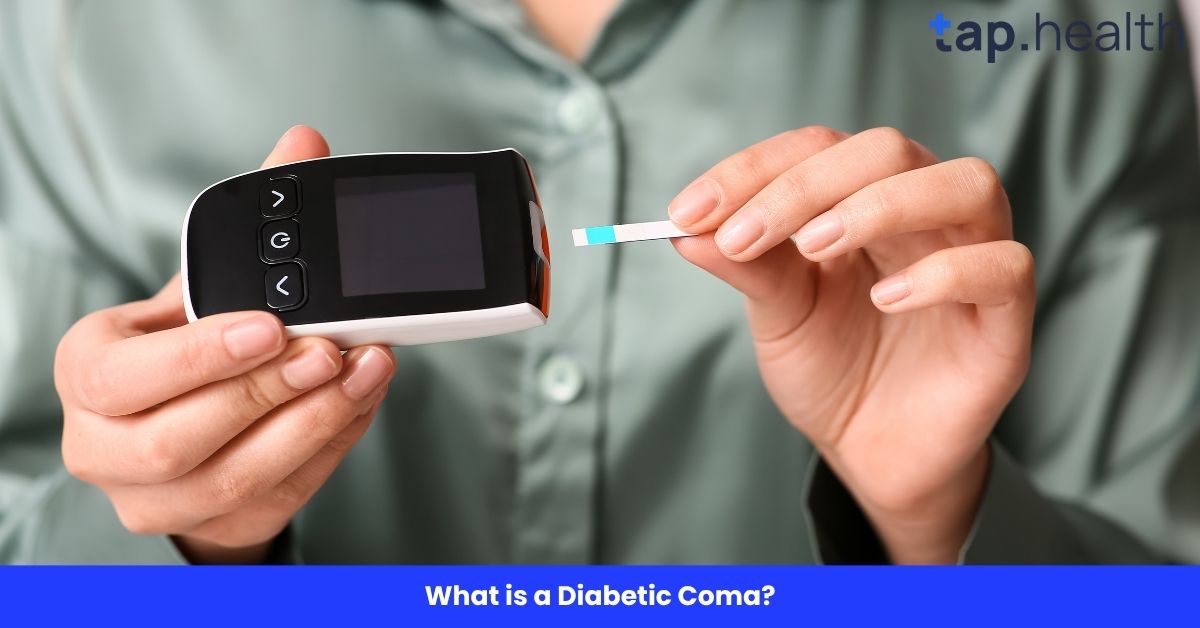A diabetic coma is a serious condition that can occur when diabetes is not well managed. It happens when a person’s blood sugar level becomes extremely high or low, causing a loss of consciousness and putting their life at risk. In this blog post, we’ll take an in-depth look at what diabetic coma is, its causes, symptoms, how it’s treated, and how to prevent it.
Understanding diabetic coma is essential for those living with diabetes and their families, as it can be a life-threatening emergency. Let’s explore this condition in detail and provide you with valuable information to prevent it.
What is a Diabetic Coma?
A diabetic coma is a state of unconsciousness caused by severely high or low blood sugar levels (hyperglycemia or hypoglycemia) in people with diabetes. It is a medical emergency that requires immediate attention. There are two main types of diabetic coma: diabetic ketoacidosis (DKA) and hyperosmolar hyperglycemic state (HHS) for high blood sugar levels, and hypoglycemic coma for low blood sugar levels.
A diabetic coma occurs when the body’s blood sugar levels become dangerously imbalanced, causing severe complications. If not treated promptly, it can lead to long-term damage or even death.
Types of Diabetic Coma
- Diabetic Ketoacidosis (DKA):
This occurs when the body starts breaking down fat at an abnormally fast rate, producing ketones. The buildup of ketones makes the blood acidic and causes a diabetic coma if not treated. - Hyperosmolar Hyperglycemic State (HHS):
This is a rare but serious condition where extremely high blood sugar leads to severe dehydration and electrolyte imbalances, causing a diabetic coma. - Hypoglycemic Coma:
This occurs when blood sugar levels drop dangerously low. Hypoglycemia can be caused by skipping meals, taking too much insulin, or excessive exercise without proper food intake.
Causes of Diabetic Coma
Understanding the causes of a diabetic coma is crucial for preventing it. Both high and low blood sugar can lead to a coma, but they occur for different reasons.
1. Diabetic Ketoacidosis (DKA) – High Blood Sugar
DKA happens when there is not enough insulin in the body. As a result, the body starts breaking down fat for energy, leading to the production of ketones. These ketones are acidic, and when they build up in the blood, they make the blood acidic, causing a condition called acidosis.
Causes of DKA:
- Insulin Deficiency: Not taking enough insulin or missing insulin injections.
- Infections: Infections, especially urinary tract infections or pneumonia, can cause high blood sugar levels and trigger DKA.
- Severe Illness or Trauma: Severe illnesses, trauma, or surgery can raise blood sugar levels and increase the risk of DKA.
- Poor Management of Diabetes: Poor control of blood sugar levels due to diet, lack of exercise, or missed medications.
2. Hyperosmolar Hyperglycemic State (HHS) – Extremely High Blood Sugar
HHS is similar to DKA but without the production of ketones. It occurs when the body becomes severely dehydrated, and the blood sugar levels rise to very high levels, causing a hyperosmolar state (extremely concentrated blood).
Causes of HHS:
- Infection or Illness: Just like DKA, infections can cause elevated blood sugar levels, which can lead to HHS.
- Dehydration: Not drinking enough fluids can lead to dehydration, which is a significant risk factor for HHS.
- Inadequate Insulin Use: Not taking enough insulin or missing insulin injections can result in high blood sugar levels and HHS.
- Medications or Steroids: Some medications can increase blood sugar levels, leading to HHS.
3. Hypoglycemic Coma – Low Blood Sugar
A hypoglycemic coma happens when blood sugar levels drop too low, leading to confusion, unconsciousness, and possibly seizures. It is most commonly seen in people with type 1 diabetes but can occur in people with type 2 diabetes as well.
Causes of Hypoglycemic Coma:
- Too Much Insulin: Taking more insulin than needed for the amount of food eaten.
- Skipping Meals or Delayed Meals: Missing meals or delaying meals can cause blood sugar levels to drop too low.
- Excessive Exercise: Exercising too much without consuming enough food can lead to hypoglycemia.
- Alcohol Consumption: Drinking alcohol on an empty stomach can lower blood sugar levels and lead to hypoglycemia.
Symptoms of a Diabetic Coma
The symptoms of a diabetic coma depend on the type of coma (DKA, HHS, or hypoglycemic coma) and whether blood sugar levels are too high or low. It is essential to recognize the early signs of a diabetic coma so that you can seek emergency medical help immediately.
Symptoms of Diabetic Ketoacidosis (DKA) Coma:
- Frequent Urination: As the body tries to eliminate excess glucose.
- Excessive Thirst: Dehydration due to excessive urination.
- Fruity-Scented Breath: The presence of ketones gives the breath a fruity odor.
- Fatigue and Weakness: The body’s inability to use glucose efficiently for energy.
- Nausea and Vomiting: Caused by the buildup of ketones in the blood.
- Rapid Breathing: Due to metabolic acidosis (acidity in the blood).
- Confusion or Unconsciousness: In severe cases, confusion or a diabetic coma can occur.
Symptoms of Hyperosmolar Hyperglycemic State (HHS) Coma:
- Extreme Thirst: A result of severe dehydration.
- Dry Mouth and Skin: Due to fluid loss and dehydration.
- Confusion: Cognitive changes due to electrolyte imbalances.
- Severe Dehydration: Dry skin, low blood pressure, and rapid heart rate.
- Seizures: In severe cases of HHS.
- Unconsciousness: In extreme cases, a person may lose consciousness.
Symptoms of Hypoglycemic Coma:
- Shakiness and Sweating: The body’s response to low blood sugar levels.
- Dizziness or Lightheadedness: Due to low blood sugar.
- Confusion and Irritability: Lack of glucose to the brain causes mental confusion.
- Blurred Vision: Low blood sugar levels can affect vision.
- Seizures or Loss of Consciousness: In severe hypoglycemia, a person may experience a coma.
How Is Diabetic Coma Diagnosed?
If someone is suspected of being in a diabetic coma, healthcare professionals will typically perform the following tests:
- Blood Glucose Test: To check if blood sugar levels are dangerously high or low.
- Blood Ketone Test (for DKA): To check for ketones in the blood, which indicates DKA.
- Electrolyte Test: To check for dehydration and electrolyte imbalances.
- Urinalysis: To check for ketones in the urine, which is common in DKA.
Treatment for Diabetic Coma
The treatment of a diabetic coma depends on the type of coma and the underlying cause (whether blood sugar is too high or too low). In general, diabetic coma is a medical emergency that requires immediate treatment.
1. Treatment for Diabetic Ketoacidosis (DKA):
- Insulin Therapy: Insulin is administered intravenously to lower blood sugar levels and stop the production of ketones.
- Fluids: IV fluids are given to rehydrate the body and correct electrolyte imbalances.
- Electrolyte Replacement: Potassium and other electrolytes are replaced as needed.
2. Treatment for Hyperosmolar Hyperglycemic State (HHS):
- Fluids: IV fluids are given to correct dehydration.
- Insulin Therapy: Insulin is used to lower blood sugar levels.
- Electrolyte Management: Electrolytes are monitored and replaced as needed.
3. Treatment for Hypoglycemic Coma:
- Glucose Administration: Intravenous glucose is given to raise blood sugar levels rapidly.
- Glucagon Injection: In severe cases, an injection of glucagon can help raise blood sugar levels.
How to Prevent a Diabetic Coma
While a diabetic coma can be a life-threatening emergency, it can usually be prevented with proper management of diabetes. Here are some tips to help prevent a diabetic coma:
1. Monitor Blood Sugar Levels Regularly:
Keeping track of your blood sugar levels and maintaining them within the recommended range can help prevent both high and low blood sugar levels.
2. Take Medications as Prescribed:
Always take your insulin or oral medications as prescribed by your healthcare provider. Adjust your dose only under medical supervision.
3. Follow a Healthy Diet:
A balanced diet with proper portion control and carbohydrate counting can help maintain stable blood sugar levels.
4. Exercise Regularly:
Physical activity helps regulate blood sugar levels and prevents complications from diabetes.
5. Avoid Skipping Meals:
Skipping meals can lead to low blood sugar levels. It’s important to eat regular meals and snacks to maintain consistent blood sugar levels.
Real-Life Scenario
Ramesh, a 45-year-old man with type 2 diabetes, skipped his insulin dose after a long day of travel. Later that night, he started feeling dizzy and extremely thirsty. By the next morning, he was unresponsive — he had slipped into a diabetic coma due to dangerously high blood sugar levels.
Emergency treatment at the hospital, including IV fluids and insulin, stabilized him. This situation highlights how missing even one insulin dose or ignoring high sugar symptoms can quickly become life-threatening.
Expert Contribution
Endocrinologists emphasize that diabetic coma is preventable with consistent monitoring and management.
According to Dr. Meena Sharma, a leading diabetologist, “Checking blood sugar levels regularly, following prescribed medication, and never skipping meals or insulin are the most effective ways to avoid diabetic emergencies.”
Experts also note that family members should recognize early warning signs — confusion, sweating, or shallow breathing — and seek help immediately.
Recommendations Grounded in Proven Research and Facts
- Monitor blood sugar daily – Use a glucometer or diabetes app to track fluctuations.
- Never skip medication or insulin – Maintain a consistent schedule.
- Stay hydrated – Dehydration can worsen blood sugar imbalances.
- Know the symptoms – Learn to identify signs of low or high blood sugar early.
- Emergency plan – Always carry a glucose tablet or ID card that indicates your diabetic condition.
- Seek immediate medical care – If you notice confusion, loss of consciousness, or abnormal breathing, call for help right away.
How Tap Health Can Help You Manage Diabetes Better
Tap Health is designed to make diabetes care simpler, smarter, and more personalized. With its AI-powered tools and real-time insights, it helps you take full control of your health every day.
Here’s how Tap Health supports you:
- Smart Meal Tracking: Take a picture of your meal and instantly get accurate carb and calorie counts, helping you make better food choices.
- Personalized Diet Guidance: Get meal recommendations tailored to your blood sugar goals and preferences.
- Glucose Monitoring Made Easy: Track your blood sugar readings and view clear trends to understand what affects your levels most.
- AI Health Coaching: Receive 24/7 support and expert-backed advice for managing food, exercise, sleep, and stress.
- Medication & Reminder Alerts: Never miss a dose or check—Tap Health keeps you on schedule effortlessly.
- Actionable Insights: The app analyzes your data and offers simple, effective tips to help you stay consistent and motivated.
Frequently Asked Questions (FAQ) on What is a Diabetic Coma?
1. What is a diabetic coma?
A diabetic coma is a life-threatening condition where a person with diabetes loses consciousness due to extremely high or low blood sugar levels. It can occur from conditions like diabetic ketoacidosis, hyperosmolar hyperglycemic state, or hypoglycemia.
2. What causes diabetic coma?
Diabetic coma can be caused by high blood sugar (due to insufficient insulin or illness), dehydration, infection, or low blood sugar (due to excess insulin, skipped meals, or excessive exercise).
3. How can diabetic coma be prevented?
Monitoring blood sugar levels regularly, taking medications as prescribed, following a healthy diet, exercising regularly, and avoiding skipping meals can help prevent a diabetic coma.
4. What are the symptoms of diabetic coma?
Symptoms include confusion, nausea, rapid breathing, excessive thirst, dry mouth, blurred vision, and loss of consciousness. Symptoms may vary depending on whether blood sugar is too high or too low.
5. How is diabetic coma treated?
Treatment depends on the type of diabetic coma but typically involves intravenous fluids, insulin therapy, and electrolyte replacement. Immediate medical attention is necessary.
Conclusion
A diabetic coma is a serious and potentially life-threatening condition that can occur due to poorly controlled blood sugar levels. Understanding the causes, symptoms, and treatment options for diabetic coma is essential for managing diabetes effectively. By maintaining regular blood sugar monitoring, taking prescribed medications, and adopting a healthy lifestyle, individuals with diabetes can reduce their risk of experiencing a diabetic coma. If you or someone you know experiences symptoms of a diabetic coma, seek immediate medical help.



